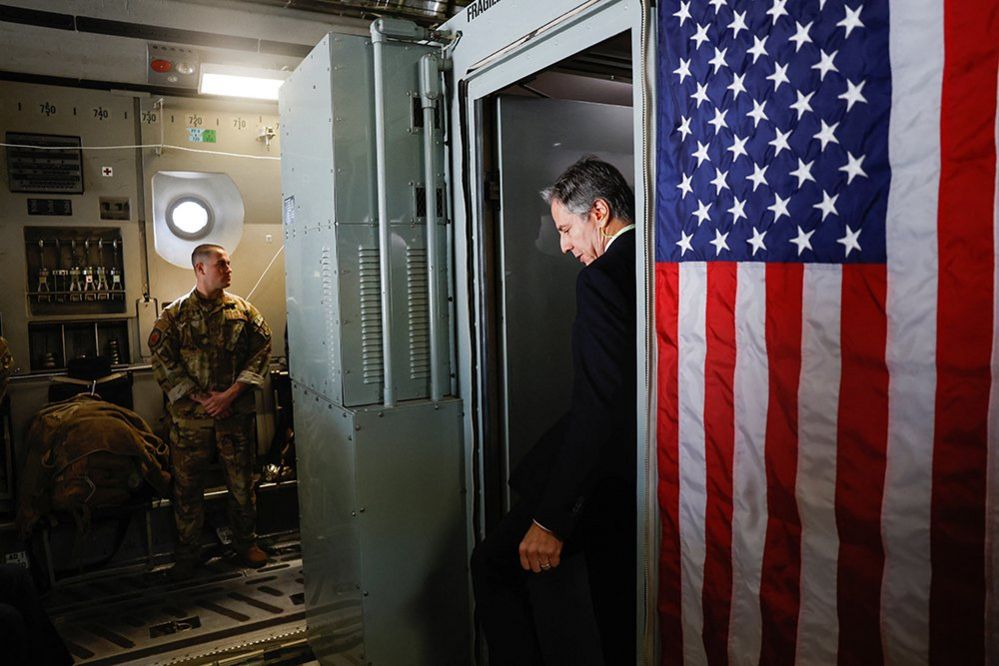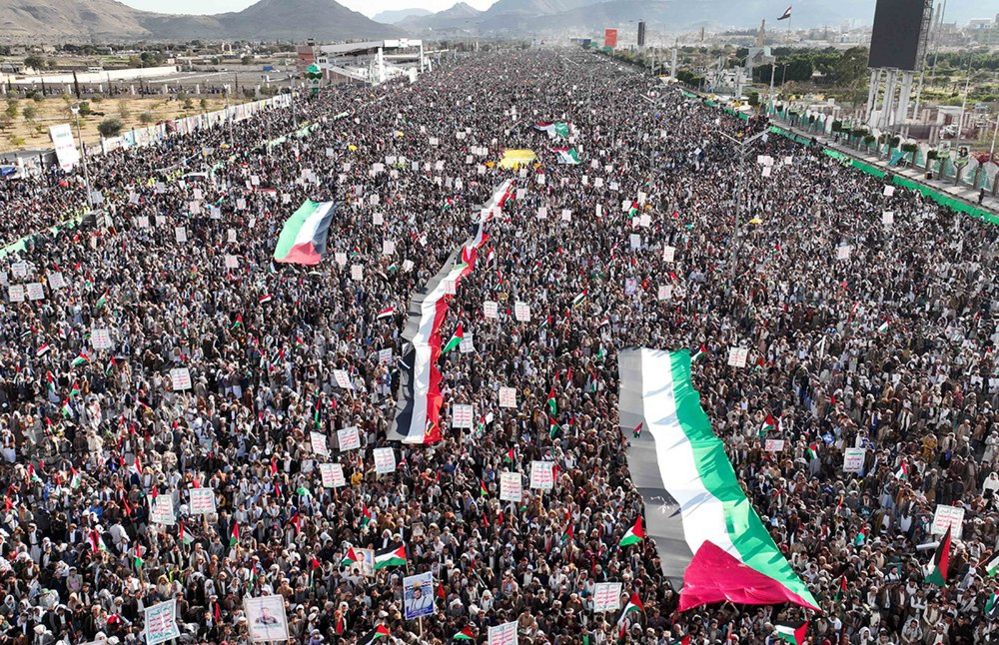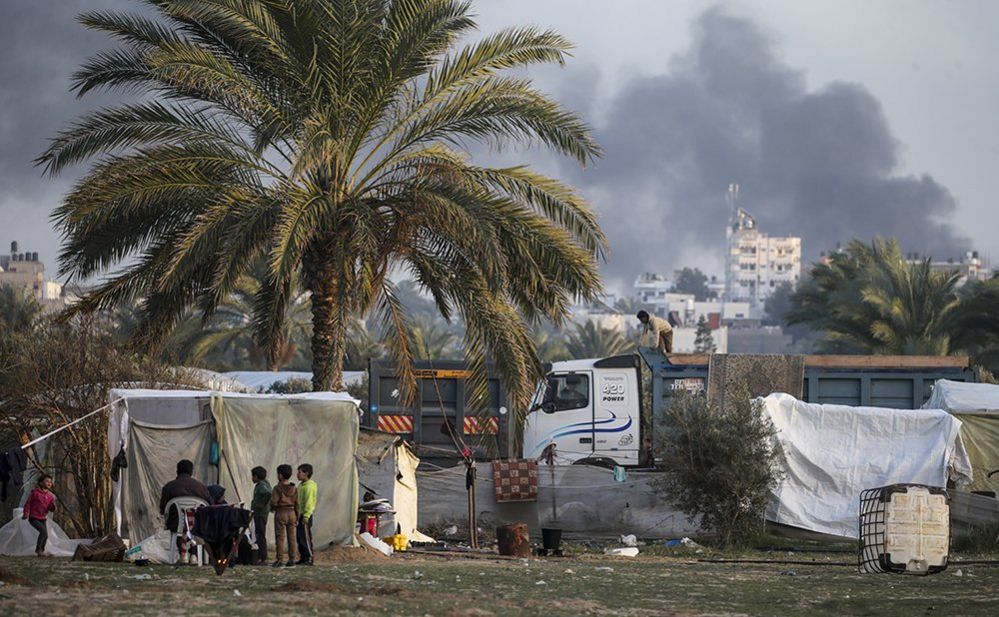
By Anthony Zurcher
North America correspondent
At a press briefing in Tel Aviv on Tuesday – after a day of meetings with Israeli leaders – US Secretary of State Antony Blinken was surprisingly upbeat.
Answering a question about the future of Gaza, he said he had just delivered a “new” and “very powerful” message to the Israelis – one that would end the cycle of violence in the Middle East once and for all.
Blinken had spent the past four days travelling around the Middle East, with three objectives – persuading Israel to wind down its offensive, reducing tensions in the region, and easing the humanitarian crisis in Gaza.
As he concluded a trip which also took in Turkey, Jordan, Qatar, the United Arab Emirates, Saudi Arabia, Bahrain and Egypt, US-led air strikes were launched at Houthis in Yemen. While Blinken flew back across the Atlantic, the attacks will have left him wondering how his second objective can be met.
But the news conference in Tel Aviv days before hinted at the possibility of progress on what lies ahead.
ADVERTISEMENT

Here was the offer: The Arab leaders would support regional integration, including normalised relations with Israel, in exchange for an end to the Gaza War, and Israel’s acceptance of a “clear path” to Palestinian political rights and a unified Palestinian state, comprising the West Bank and Gaza.
The plan, Blinken says, would have the additional benefit of isolating Iran and reducing what he said was its malign efforts to destablise the region through proxy actors like Hezbollah, Hamas and the Houthi movement.
The US secretary has acknowledged that adopting the American proposal would require some hard choices on the part of the Israelis, but he insisted that the promise of a durable regional peace was worth the effort.
“The other path,” Blinken said, “is to continue to see the terrorism, the nihilism, the destruction by Hamas, by the Houthis, by Hezbollah, all backed by Iran.”
A senior US State Department official, speaking on background, was even more blunt – Israel ultimately doesn’t have a choice.
At some point, the official told me, Prime Minister Benjamin Netanyahu and the Israelis would have to face the reality that if they don’t make concessions to their Arab neighbours, they will be left dealing with the chaos and devastation they created in Gaza on their own.
The Arabs simply will not fund yet another rebuild, and no-one – including the Americans – has any interest in participating in the kind of multinational peacekeeping force that Israeli Defence Minister Yoav Gallant suggested last week.
“Other Arab countries will not contribute to the reconstruction of Gaza unless it is part of a bigger political settlement,” says Kim Ghattas, a Lebanon-based Middle East expert and author of Black Wave, a book on the Saudi-Iran rivalry. “Netanyahu doesn’t seem to have grasped that yet.”

This, in essence, has become the American strategy for the Gaza War endgame. The carrot for the Israelis is normalisation and regional stability. The stick? Well, the stick is that there are no other carrots out there. Just a lot of bad options.
The stick certainly isn’t the threat of terminating, or even placing conditions on, US aid to the Israelis, which American officials, from President Joe Biden on down, have routinely ruled out.
There are other components to the American plan, including pressuring the Palestinian Authority to enact political and judicial reforms – addressing corruption, increasing transparency and loosening media restrictions – that would position it to govern a unified Palestinian state.
On Wednesday, Blinken’s armoured motorcade rolled from Tel Aviv to Ramallah in the West Bank for a closed-door meeting with Palestinian Authority President Mahmoud Abbas – talks, the US secretary said, that resulted in a commitment to enact meaningful change.
Dov Waxman, a professor of Israel studies at UCLA, is not certain such a commitment is solid, however.
“Since the Palestinian Authority is now widely perceived by Palestinians to be illegitimate, it makes it very hard for its officials, including Abbas himself, to support democratising because doing so would jeopardise their own rule and even the Authority’s continued existence,” he said.
If Blinken’s trip was heavy on discussion of a seemingly distant future of regional peace, it was short on concrete details about how to get to that point. Israel, at least so far, has shown few signs of winding down its Gaza campaign – an essential first step before any grand American-brokered deal can begin to take shape.
“The Biden administration is somehow still hoping it can put this on the table as an end goal to work towards, using the normalisation talks as lever or momentum, including to convince the Israelis to get on board the process,” says Ghattas. “That’s all fine in theory, but in practice it’s going to be very hard.”
While the Americans have said Israel is on the verge of lowering the tempo of its campaign, in the south of Gaza, around the town of Khan Younis, Israel’s efforts have been intensifying of late.
Blinken did announce on Tuesday night that the Americans and Israelis had reached an agreement to allow a UN-led “assessment mission” to enter the northern part of the Gaza Strip to determine when Palestinian civilians can return to their homes.
The plan was light on details, however, and the assessment is almost certain to be bleak. Blinken acknowledged that the effort won’t achieve results “overnight”. Much of Gaza City has been reduced to rubble, unexploded ordnance is a concern, and public services are limited at best.

In fact, Gaza as a whole is teetering on the brink of a humanitarian abyss.
Early in the trip, Blinken visited a World Food Programme warehouse in Amman, Jordan, that serves as a depot for aid to Gaza. Before his arrival, Sheri Ritsema-Anderson, UN resident coordinator at UN Jordan, painted a dire picture of the situation for Palestinian civilians.
“In the last 15 years that I’ve been in the Middle East, I’ve not seen a situation like this,” she told me. “This is catastrophic.”
It’s not just food, she added. Power stations and wastewater facilities need fuel. Hospitals need supplies and equipment. The number of aid trucks entering Gaza, through circuitous routes from Jordan and elsewhere, are not nearly enough.
Talking to reporters in Cairo before departing the region on Thursday, Blinken bristled at the suggestion that the Americans have been too focused on long-term planning instead of the more pressing humanitarian concerns.
“We’re very focused on this,” he said. “It is vital that as long as this is going on, every effort is be made to make sure that civilians who are caught in the crossfire of Hamas’s making don’t continue to suffer.”
The numbers are what they are, however. The conflict has resulted in the death of more than 23,000 Palestinian civilians so far, according to the Hamas-run health ministry in Gaza. And American – and Blinken’s – attention is stretched thin, as was clearly demonstrated during his Middle East tour.
Houthi rebel attacks on commercial shipping have virtually shut down the Red Sea. The clashes between Israeli and Hezbollah along the Israel-Lebanon border appear to be intensifying. US forces in Syria and Iraq are under attack by Iran-backed militias.
The situation was fraught when Blinken arrived in the region on Friday 5 January. It remains so as he concluded his fourth solo trip here since the war began.
There is sure to be a fifth trip soon enough. And many more.
“I think the Biden administration is desperately trying to do some damage-control over its continued support for the war and opposition to an immediate ceasefire,” UCLA’s Waxman said.
The White House, he said, wants to assure Arab allies – and domestic critics within Biden’s Democratic Party – that they understand Palestinian grievances and aren’t giving Israel a green light for unconstrained warfare.
With this latest seven-day, 10-stop diplomatic effort, the Americans appear determined to prove they are inexhaustable, if nothing else. And they seemed convinced that the effort, even if it appears to be short on results at the moment, is proof of continuing American power and influence.
“The path is clearly there,” Blinken said of a way to regional peace. “It’s possible. We can see it.”
A journey of a thousand miles begins with a single step, as the saying goes. But the American secretary on this trip spent considerably more time talking about where the path ends than how it might start.https://blejermot.com/